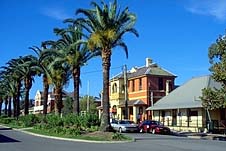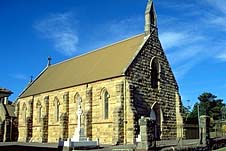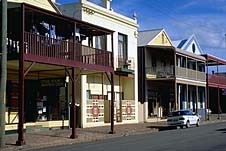
|
| Palm trees and elegant
buildings in Port Stephens Road, Raymond Terrace
|
Raymond Terrace (including Tomago and Williamtown)
Small town on the Hunter River with interesting historic
buildings
Raymond Terrace, the administrative centre of the Port
Stephens Shire, is located 177 km north of Sydney via the
Pacific Highway and 12 m above sea-level. It is now
virtually a commuter belt township attached to Newcastle, 23
km to the south. Its population in 1991 was 11,159.
The area was originally occupied by the Worimi
Aborigines. The town's name comes from a member of
Lieutenant John Shortland's party, by the name of Raymond,
who explored the area in 1797 and described the 'terraced'
appearance of the trees. Lieutenant-Colonel Paterson, then
Lieutenant Governor of NSW, stepped ashore at the river
junction in 1801 while on a survey expedition of the Hunter.
Governor Macquarie visited the site in 1812 and 1818 with
a view to establishing a new settlement to the north,
referring to the site as Raymond Terrace in his journal.
Cedar-getters were the first Europeans to inhabit the area
and they were soon followed by farmers.
The townsite was surveyed in 1822-23. In 1828, James King
was granted 1920 acres 8 km north of present-day Raymond
Terrace. Naming his Australian property Irrawang he cleared
the land, cultivated wheat, began grazing cattle, bred
horses and, from 1833-34, built a homestead. In 1831 he
started an experimental vineyard from French, Portuguese and
Spanish vines and began making pottery. Both enterprises
were soon flourishing. He started more vineyards at Tomago
and Seaham and built a winery in 1836. King obtained 100
acres by the Hunter River at Raymond Terrace to facilitate
the shipment of his supplies. He became a principal founder
of the Hunter River Vineyard Association in 1847.
Raymond Terrace was gazetted in 1837 and land sales began
in 1838. A courthouse, police station, steam-driven flour
mill and punt were soon established. It became an important
shipping centre in the 1840s for wool carted by road from
New England. In 1848 there were 263 recorded inhabitants.
Shipping continued into the 1920s but the town had long
been in decline by then as traffic was diverted to New
England when the Hunter River began silting up. The railway
to Maitland also bypassed the town, the wheat was hit by
wheat rust and the winegrowers moved on to better pastures
elsewhere in the Hunter Valley.
The arrival of industry in the 1930s revived the local
economy. The construction of an aluminium smelter at Tomago
in the 1980s increased the local population. Tomago, 14 km
to the south, was essentially a coal mining village until a
rayon plant was built there in 1950. An RAAF base and civil
airport was established at Williamtown in 1941.
Things to see:
![[Top of page]](smlArrow.gif)

|
| St Brigids Catholic
Church |
William Street
If you are approaching Raymond Terrace from the south turn
right at the traffic lights into William St, the main
shopping strip. Just as you complete the turn, to your
immediate left, is a good parking spot opposite the Uniting
Church and adjacent a vacant lot. Just beyond you, to the
left, is the Catholic Presbytery (1891), restored and
extended in 1971. It has a lovely verandah with cast-iron
lacework atop ornamental pillars. Two doors along is St
Brigid's Catholic Church (1860-62), built of local sandstone
in the Gothic style. Boomerang Park opposite was formerly
the site of a local quarry which furnished the sandstone for
many early buildings.
Muree Cemetery is on the other side of the park. The
oldest headstone dates from 1845 and belonged to Ann Macansh
who, it is claimed, was a direct descendant of the Haig
family, the famous whiskey distillers. It is said that she
left Scotland in disgust when a Scottish law forbade her (as
a woman) inheriting a fortune related to the Haig estate.
Walk across the highway to the other side of William St.
Next door to the courthouse are the council offices where
you can obtain a heritage tour pamphlet. The rendered brick
courthouse (1841) was designed by Mortimer Lewis, colonial
architect from 1835 to 1850. Of particular note are the
gable-roofed courtroom and the front verandah supported by
columns with cast-iron filigree brackets.

|
| Historic verandahed
buildings in King Street |
King Street
Walk down William St towards the river. Take the last right
into King St, the business centre of Raymond Terrace from
1840 until the 1955 flood immersed it and shifted trade
around the corner. A telegraph pole along the street to your
right, opposite the old Masonic centre (now a neighbourhood
centre), indicates the level to which the flood rose - about
3.5 m above street-level.
The attractive 19th-century timber buildings with
post-supported verandahs are very well preserved. Some date
back to the 1840s. The two large trees halfway along the
street, to the left, are, the sign says, 'marriage trees'.
These trees were used by the locals for weddings prior to
the establishment of the town's churches.
Riverbank Park
Return to William St and follow it the few metres to
Riverbank Park, adjacent the Hunter River, located on the
site formerly occupied by a large group of stone buildings,
some relating to James King's pottery business. His wharf
and the last of the buildings were demolished in the 1960s.
The park has play facilities and is a very pleasant spot.
On the corner of William and Hunter Sts is the Junction
Inn. The oldest portion dates from 1836 when it served as
King's Hotel, a post office and King's business premises.
Although little of the original building remains it is
considered the second-oldest hotel in NSW. At 3 Hunter St is
Windeyer Cottage (c.1880), an attractive timber building. At
7 Hunter Street is Geer House, built of sandstone for James
Cadell in 1845.
Glenelg Street
The first crossroad is Glenelg St. Another telegraph pole
bears a flood marker. If you turn right and walk to the
water's edge you will find yourself at Colonel Paterson's
original 1801 landing site. Return along Glenelg St. Duck
down Port Stephens St on your left. On the right-hand side
of the road is an old stone cottage and the 1880 government
post office, currently vacant.
Return along Port Stephens St to Glenelg.On the corner is
a piece of heavy artillery adjacent a war memorial which
includes the names of numerous locals who died in the Boer
War. Two doors along is St John's Parish Hall. The original
building was the town's first Anglican church, a slab
structure built in 1841. Sandstone was erected around the
original structure in 1862. A few doors further along
Glenelg St is an old stone cottage, originally the rectory
of St John's Parish (c.1841). At the intersection with
Sturgeon St is another old stone cottage in an excellent
state of preservation. Thought to have been built before
1862 it now houses the post office. A little further down,
and on the opposite side of the road is another stone
cottage, again well preserved and dating from the 1860s.
Return south along Sturgeon St across Glenelg St. On the
left is St John's Anglican Church, erected in 1862 according
to a design of Edmund Blacket, noted for his work on the
churches of Sydney and some of the University of Sydney
buildings. It is built in the Gothic Revival style out of
sandstone from the local quarry. The separate and larger
bellcote was added later. The current bell is from the wreck
of the Ceres off North Head in 1835. A few doors south along
Sturgeon St, and on the opposite side of the road, is the
rectory (1862). The building is almost on a corner block so
duck around the corner into Jacaranda Ave if you wish to see
the facade. There are two gigantic pine trees in the grounds
Sketchley Pioneer Cottage Museum
Return along Jacaranda Ave into Sturgeon St. At the corner
with Swan St is 'Slade House', a two-storey cottage dating
from 1890 and erected on the site of a cottage owned by a
Colonel Snodgrass, acting governer of NSW from 1837-1838.
Now known as 'Coo-ee' this is a rather beautiful building
with ornate cast-iron curlicues along the verandah and
balcony, gorgeous stained-glass windows about the doorway
and particularly impressive window frames.
Head along Swan St back to the highway and turn right.
After 150 m you will come to Sketchley Pioneer Cottage
Museum. Now the precinct of the local historical society
this rare surviving example of an early colonial pit-sawn
split-slab farmhouse. It was built in c.1850 by ex-convict
William Sketchley who was transported in 1830. After his
release he bought land 8 km north of Raymond Terrace and its
was there that the cottage was built. Although twice covered
by floodwaters Sketchley's descendants remained in the house
until the mid-twentieth century and still reside in the
district. Today it contains early Australian examples of
farm equipment, furniture, handicrafts and fine linen. It is
open Sundays from 10.00 a.m. to 4.00 p.m. or by appointment,
tel: (02) 4988 6425. Adjacent is a park with appropriate
facilities and a jet fighter plane suspended atop a stand.
Hunter Botanic Gardens
4.5 km south along the highway, to the left, are the Hunter
Botanic Gardens. These beautiful grounds were developed and
are maintained, remarkably, on a volunteer basis, hence
donations are non-compulsory but welcome. Walks have been
established through the wildflowers and other native
vegetation. The visitors' centre has a botanic library and
the Gardens host a Spring Fair each September.
Tomago House
Continue south for another 2.5 km and take the left turn
into Tomago Rd following the signposts to Williamtown and
Nelson Bay. 4 km along this road you will see a small
sandstone chapel in an open field to your right. Just beyond
it a brown signpost indicates the entry to Tomago House,
built for barrister Richard Windeyer who bought up 30 000
acres of land in the Hunter Valley between 1838 and 1842.
Becoming a member of the first Legislative Council in 1843
he was also an eager participant in social welfare groups,
including the Aboriginal Protection Society. Planning an
elaborate agricultural estate he purchased 850 acres in the
area, drained the swamps near Grahamstown, planted grape
vines, sugar cane and wheat, grazed cattle, horses and pigs
and began work on the construction of the centrepiece,
Tomago House, in 1843. It became the property of the
National Trust in 1986.
Tomago House is a gracious and elegant mansion of
finely-tooled sandstone shipped by barge from the Raymond
Terrace quarry. Its highlights include a marble fireplace,
ornate cornices, a central hall with raised roof, sandstone
carving about the exterior, frosted glass panels surrounding
the door and outstanding plasterwork and cedar joinery. The
drawing room and dining room are particularly impressive
with gorgeous bay windows looking out across pleasant
grounds and French doors opening out to a flagged sandstone
verandah with delicate cast-iron columns.
The modest chapel was designed by Maria Windeyer and her
sister and built of sandstone rubble left over from the
house's construction. It was intended for the worship of her
family, neighbours and the estate-workers. The cedar pews,
lectern and joinery are original. Plaques on the wall
memorialise Maria, her family and descendants. Their ashes
were scattered nearby.
These buildings are open every Sunday from 11.00 a.m. to
3.00 p.m. Being run by volunteers the house will open at
other times for groups if an appointment is made and some
cover charge paid, tel: (02) 4964 8123. Necessary
restorations are paid for by fund-raising so the house and
chapel can be hired for weddings and other functions.
Tomago Sandbeds Water Supply Scheme
About 3 km along to the left is the Tomago Sandbeds Water
Supply Scheme. The sandbeds are situated on an impervious
shingle bed and retain water like a sponge. Wells were dug
here from the very early days of European settlement and the
water shipped to Newcastle. Horse-driven pumps were
installed in the 1860s to draw the water and fill two 20
000-gallon wooden tanks which were carried to Newcastle by
two steamers. The beds also support a rich and varied flora
especially when the wildflowers bloom in spring.
Fort William
Continue along this road for another 10.5 km then turn left
at the T-intersection into Nelson Bay Rd, following the sign
for Nelson Bay and Williamtown. After another kilometre you
can turn left into Sandeman Rd if you wish to visit the
Monarch Historical Museum at 'Fort William', an unusual
castellated building which is plainly visible from the
highway. tel: (02) 4965 1641. It is owned by noted
cartoonist Monty Wedd and houses a diverse and interesting
collection of historical memorabilia, some dating back to
early last century.
Fighter World
You are now in Williamtown, as the persistent and deafening
roar of passing fighter planes would suggest. The RAAF base
was established in 1941 and a parachute training school was
set up in 1951, utilizing the Tilligerry Peninsula (see
entry on Port Stephens) as the drop area.
Also at the base is Fighter World which is very popular
with young children.. Continue along Nelson Bay Rd for 300 m
to the roundabout and take a left into Medowie Rd and the
entrance is 500 m along to your left.There are nine fighter
aircraft on display that can be inspected at close quarters,
several actual cockpits set up for the young to sit in, a
very large display of entirely accurate miniature wooden
aircraft models, missiles, weapons and other military items.
There is also a viewing platform from which to watch the
base's hornets come in to land, an eatery, souvenirs and a
video. They are open every day from 10.00 a.m. to 4.00 p.m.,
tel: (02) 4965 1810.
Tomteland
At 173 Nelson Bay Rd, Wiliamtown, is Tomteland Fun Park
which is open daily from 10.00 a.m. to 5.00 p.m. Attractions
include substantial water rides, bumper cars, a craft
village and craft workshops, large-scale carnival rides,
mini-golf, a laser runner maze, a carousel, a small ferris
wheel and other young children's amusements, along with a
natural lake with ducks, a picnic area with barbecue
facilities, a restaurant, a cafe and an ice-creamery. For
further information ring (02) 4965 1500 or eail them at
admin@tomteland.com.au. Their website is
www.tomteland.com.au
Sand Safaris Active Adventure Tours operate from the same
premises (tel: 02 4965 0215 or info@sandsafaris.com.au).
River Activities and Grahamstown Lake
Raymond Terrace's riverbank location makes it a good spot
for waterskiing, boating and riverside picnics. There are
two boat ramps in town: one off Riverside Park in Hunter St
and another on the northern side of the Fitzgerald Bridge
which is a good place to have a look at the river junction.
The Oz Ski races (one of the world's richest waterskiing
tournaments) are held each March and the town's Twin Rivers
Festival in October.
Grahamstown Lake is adjacent the Pacific Highway just
northeast of Raymond Terrace and is really very beautiful.
It is less developed and populated than Lake Macquarie with
quiet, gentle foreshores and lengthy periods without a sole
or a residence in sight. There is a picnic area by
Richardson Rd which runs off the highway along the lake's
southern shore.

Broadwalk
Business Brokers
Broadwalk Business
Brokers specialise in General Businesses for Sale, Caravan Parks for
Sale, Motels for Sale, Management Rights & Resorts for Sale, Farms for
Sale, Hotels for sale,Commercial & Industrial Properties for Sale.
Phone:
1300 136 559
Email:
enquiries@broadwalkbusinessbrokers.com.au
AUSTRALIAN BUSINESSES FOR SALE
COFFS HARBOUR BUSINESS BROKERS
BROADWALK BUSINESS BROKERS
GOLD COAST BUSINESSES FOR SALE
BRISBANE BUSINESSES FOR SALE
SYDNEY BUSINESSES FOR SALE
CARAVAN PARKS FOR SALE
BUSINESSES FOR SALE
MOTELS
FOR SALE
HOTELS
FOR SALE
Disclaimer
We advise prospective purchasers that we take no
responsibility for the accuracy of any information in the business
provided by vendors or their professional advisers and that they should
make their own enquiries as to the accuracy of this information,
including obtaining independent legal and/or accounting advice
Raymond
Terrace